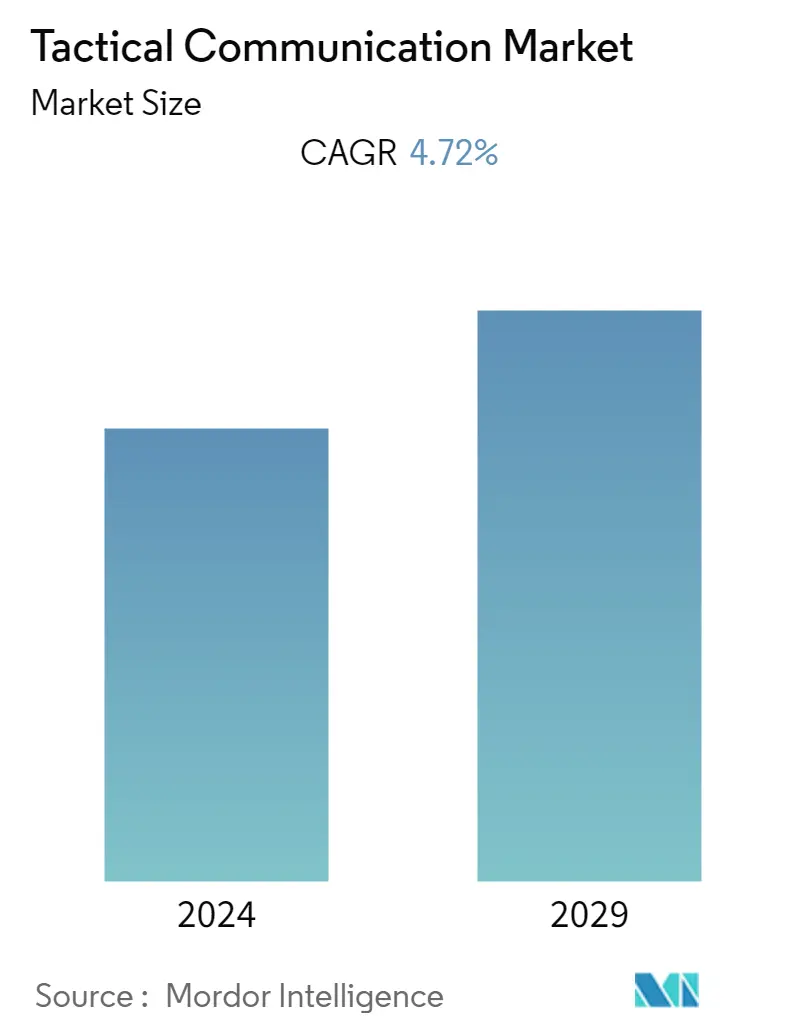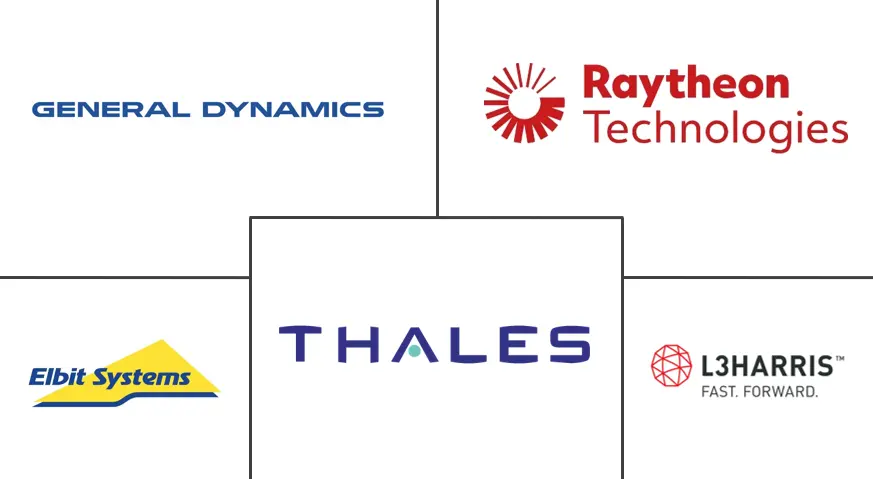Market Size of Tactical Communication Industry

| Study Period | 2019 - 2029 |
| Base Year For Estimation | 2023 |
| Forecast Data Period | 2024 - 2029 |
| CAGR | 4.72 % |
| Fastest Growing Market | Asia Pacific |
| Largest Market | North America |
Major Players
*Disclaimer: Major Players sorted in no particular order |
Tactical Communication Market Analysis
The tactical communication market is estimated to reach USD 17.27 billion by 2030, registering a CAGR of 4.72% during the forecast period (2021 - 2030).
The COVID-19 pandemic and the subsequent travel restrictions and lockdowns have caused disruptions in the supply chains of various players in the market. However, players have adjusted their operations in response to the pandemic in the latter half of the year, which has mitigated the pandemic's impact on the market.
According to SIPRI, global military spending witnessed an increase of 2.6% in 2020, despite the fall in the global GDP. Nevertheless, defense spending may come down in the near future due to the global economic turndown triggered by the pandemic. This can challenge the growth of the market during the forecast period.
The rapid shift toward asymmetric warfare is forcing the militaries to develop their tactical communication capabilities. To improve combat effectiveness, the global armed forces are focusing on enhancing the network-based communication capabilities of their military platforms across the land, air, and sea domains, which is driving the growth of the market.
Also, the increasing investments toward the integration of advanced battlefield technologies and growth in demand for network-centric warfare and satellite-based communication are anticipated to propel the demand in the tactical communication market during the forecast period.
Tactical Communication Industry Segmentation
Tactical communication is military communication in which information of any kind, especially orders and military intelligence, is conveyed from one command, person, or place to another on a battlefield, particularly during the conduct of combat. The market is segmented by application (airborne, naval, and land) and geography (North America, Europe, Asia-Pacific, Latin America, and Middle-East and Africa). The report offers the market sizes and forecasts in value (USD billion) for all the above segments.
| Application | |
| Airborne | |
| Naval | |
| Land |
| Geography | |||||||
| |||||||
| |||||||
| |||||||
| |||||||
|
Tactical Communication Market Size Summary
The tactical communications market is poised for growth, driven by the increasing need for advanced communication systems in military operations. The shift towards asymmetric warfare has necessitated the enhancement of network-based communication capabilities across various military platforms, including land, air, and sea. This demand is further fueled by the integration of advanced battlefield technologies and the growing emphasis on network-centric warfare and satellite-based communication. The market is witnessing a surge in the development of sophisticated land-based communication systems, such as manpack radios and SATCOM-on-the-move solutions, which are essential for maintaining secure communications in dynamic operational environments. The advent of 5G and future 6G networks is expected to revolutionize tactical communications, offering improved data bandwidth and connectivity for ground forces.
North America dominates the tactical communications market, with the United States leading in military expenditure and investment in communication technologies. The U.S. military's focus on procuring software reprogrammable radios and advancing satellite communication programs underscores the region's commitment to enhancing its tactical communication capabilities. Similarly, Canada is set to invest significantly in portable communication systems. The market is characterized by fragmentation, with key players like L3Harris Technologies, General Dynamics, and Thales Group driving innovation and expansion. The emphasis on indigenous manufacturing, as seen in initiatives like India's 'Make in India,' is fostering the growth of local players, contributing to the market's dynamic landscape. These developments are expected to bolster the market's growth trajectory in the coming years.
Tactical Communication Market Size - Table of Contents
-
1. MARKET DYNAMICS
-
1.1 Market Overview
-
1.2 Market Drivers
-
1.3 Market Restraints
-
1.4 Porter's Five Forces Analysis
-
1.4.1 Threat of New Entrants
-
1.4.2 Bargaining Power of Buyers/Consumers
-
1.4.3 Bargaining Power of Suppliers
-
1.4.4 Threat of Substitute Products
-
1.4.5 Intensity of Competitive Rivalry
-
-
-
2. MARKET SEGMENTATION (Market Size by Value - USD billion)
-
2.1 Application
-
2.1.1 Airborne
-
2.1.2 Naval
-
2.1.3 Land
-
-
2.2 Geography
-
2.2.1 North America
-
2.2.1.1 United States
-
2.2.1.2 Canada
-
-
2.2.2 Europe
-
2.2.2.1 Germany
-
2.2.2.2 United Kingdom
-
2.2.2.3 France
-
2.2.2.4 Russia
-
2.2.2.5 Rest of Europe
-
-
2.2.3 Asia-Pacific
-
2.2.3.1 China
-
2.2.3.2 India
-
2.2.3.3 Japan
-
2.2.3.4 South Korea
-
2.2.3.5 Rest of Asia-Pacific
-
-
2.2.4 Latin America
-
2.2.4.1 Brazil
-
2.2.4.2 Rest of Latin America
-
-
2.2.5 Middle-East and Africa
-
2.2.5.1 Saudi Arabia
-
2.2.5.2 United Arab Emirates
-
2.2.5.3 Turkey
-
2.2.5.4 Rest of Middle-East and Africa
-
-
-
Tactical Communication Market Size FAQs
What is the current Tactical Communication Market size?
The Tactical Communication Market is projected to register a CAGR of 4.72% during the forecast period (2024-2029)
Who are the key players in Tactical Communication Market?
L3Harris Technologies, Inc, General Dynamics Corporation, Thales Group, Elbit Systems Ltd. and Raytheon Technologies Corporation are the major companies operating in the Tactical Communication Market.

